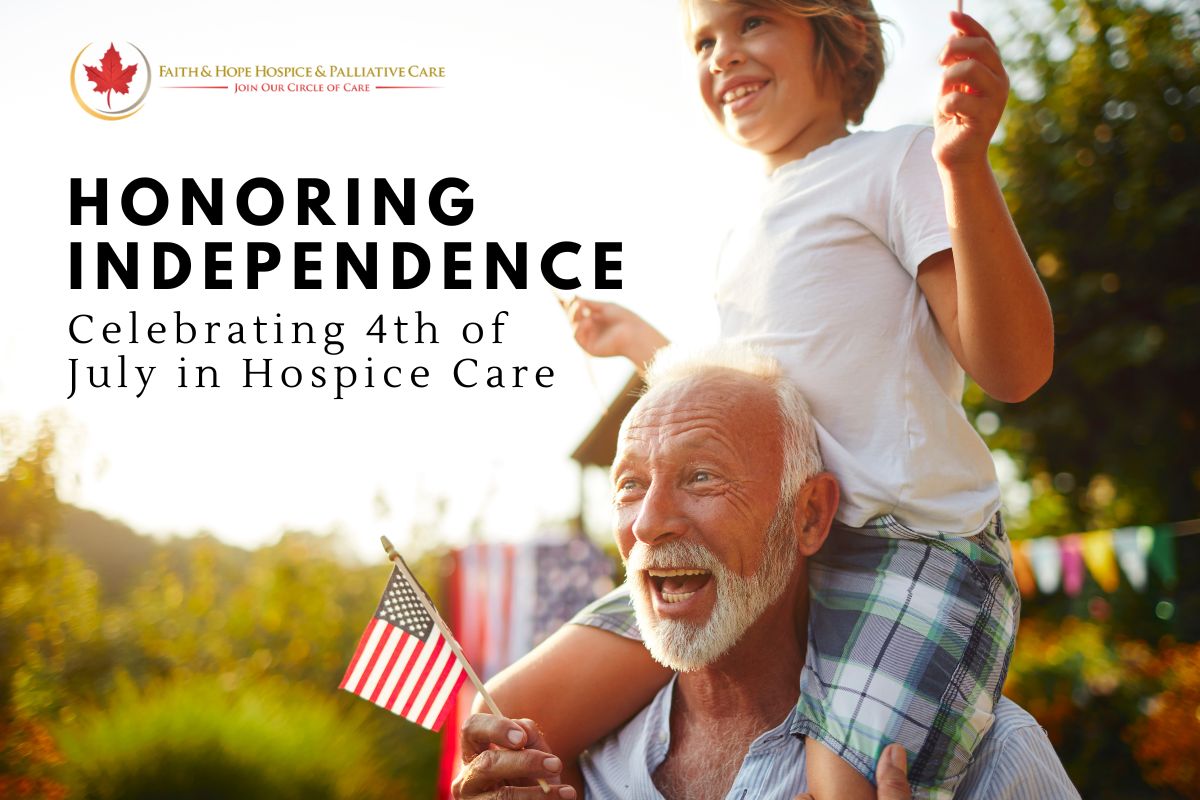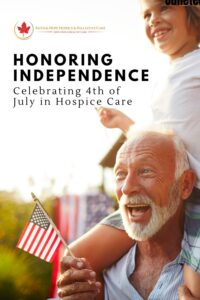
Hospice care is a compassionate service that provides comfort, support, and dignity to individuals with terminal illnesses. While the 4th of July is typically associated with fireworks, barbecues, and festivities, it’s also an opportunity to honor independence and compassion by extending the celebration to those in hospice care. This article explores the significance of commemorating the 4th of July in Los Angeles hospice care, highlighting the importance of recognizing and supporting the patients’ independence, fostering a sense of community, and nurturing compassion during this patriotic holiday.

The concept of independence takes on a different meaning for those in hospice care. By acknowledging and respecting the autonomy of each individual, we can honor their independence. Here’s how to celebrate independence in hospice care on the 4th of July:
Tailor celebrations to reflect the unique preferences and interests of the patients. Engage in conversations to learn about their favorite aspects of Independence Day, such as patriotic music, stories of courage, or even cherished memories of previous celebrations.
Decorate the patients’ rooms with patriotic themes, including flags, red, white, and blue accents, or other symbols of freedom. These visual elements can evoke feelings of pride and independence, creating a festive atmosphere within the hospice environment.
The 4th of July is a day of coming together as a nation, and it is equally important to foster a sense of community in hospice care. Here are some ideas on how to create a communal celebration:
Organize engaging activities that encourage patients, their families, and staff members to connect and celebrate together. This effort can include arts and crafts sessions, sharing stories and memories, or watching patriotic movies or parades.
Food has a remarkable ability to bring people together. Arrange a special meal, such as a barbeque or picnic, where patients, families, and staff can gather and share a sense of camaraderie. Consider offering a range of options to accommodate dietary restrictions or preferences.
Compassion lies at the heart of hospice care, and the 4th of July offers an opportunity to demonstrate and promote acts of kindness and empathy. Here’s how to nurture compassion during this holiday:
Encourage community members to volunteer their time on Independence Day to engage with hospice patients. This effort could involve offering companionship, reading aloud, playing music, or simply being present to listen and provide emotional support.
The 4th of July can be an emotionally taxing time for patients and their families, as they may be reflecting on the lives of loved ones who have served in the military or passed away. Consider organizing memorial activities, such as candlelight ceremonies or writing letters expressing gratitude and remembrance.
Celebrating the 4th of July in hospice care is a meaningful way to honor independence and compassion. By recognizing the unique needs and preferences of each individual, fostering a sense of community, and nurturing compassion, we can create a memorable and uplifting experience for patients, their families, and staff. Let us embrace the spirit of independence and compassion as we come together to celebrate this patriotic holiday in hospice settings. Call us at
(877) 797-1977 or email info@faithandhopehospice.com to connect with our Los Angeles hospice care today.
Faith and Hope Hospice
We firmly believe that the internet should be available and accessible to anyone, and are committed to providing a website that is accessible to the widest possible audience, regardless of circumstance and ability.
To fulfill this, we aim to adhere as strictly as possible to the World Wide Web Consortium’s (W3C) Web Content Accessibility Guidelines 2.1 (WCAG 2.1) at the AA level. These guidelines explain how to make web content accessible to people with a wide array of disabilities. Complying with those guidelines helps us ensure that the website is accessible to all people: blind people, people with motor impairments, visual impairment, cognitive disabilities, and more.
This website utilizes various technologies that are meant to make it as accessible as possible at all times. We utilize an accessibility interface that allows persons with specific disabilities to adjust the website’s UI (user interface) and design it to their personal needs.
Additionally, the website utilizes an AI-based application that runs in the background and optimizes its accessibility level constantly. This application remediates the website’s HTML, adapts Its functionality and behavior for screen-readers used by the blind users, and for keyboard functions used by individuals with motor impairments.
If you’ve found a malfunction or have ideas for improvement, we’ll be happy to hear from you. You can reach out to the website’s operators by using the following email
Our website implements the ARIA attributes (Accessible Rich Internet Applications) technique, alongside various different behavioral changes, to ensure blind users visiting with screen-readers are able to read, comprehend, and enjoy the website’s functions. As soon as a user with a screen-reader enters your site, they immediately receive a prompt to enter the Screen-Reader Profile so they can browse and operate your site effectively. Here’s how our website covers some of the most important screen-reader requirements, alongside console screenshots of code examples:
Screen-reader optimization: we run a background process that learns the website’s components from top to bottom, to ensure ongoing compliance even when updating the website. In this process, we provide screen-readers with meaningful data using the ARIA set of attributes. For example, we provide accurate form labels; descriptions for actionable icons (social media icons, search icons, cart icons, etc.); validation guidance for form inputs; element roles such as buttons, menus, modal dialogues (popups), and others. Additionally, the background process scans all the website’s images and provides an accurate and meaningful image-object-recognition-based description as an ALT (alternate text) tag for images that are not described. It will also extract texts that are embedded within the image, using an OCR (optical character recognition) technology. To turn on screen-reader adjustments at any time, users need only to press the Alt+1 keyboard combination. Screen-reader users also get automatic announcements to turn the Screen-reader mode on as soon as they enter the website.
These adjustments are compatible with all popular screen readers, including JAWS and NVDA.
Keyboard navigation optimization: The background process also adjusts the website’s HTML, and adds various behaviors using JavaScript code to make the website operable by the keyboard. This includes the ability to navigate the website using the Tab and Shift+Tab keys, operate dropdowns with the arrow keys, close them with Esc, trigger buttons and links using the Enter key, navigate between radio and checkbox elements using the arrow keys, and fill them in with the Spacebar or Enter key.Additionally, keyboard users will find quick-navigation and content-skip menus, available at any time by clicking Alt+1, or as the first elements of the site while navigating with the keyboard. The background process also handles triggered popups by moving the keyboard focus towards them as soon as they appear, and not allow the focus drift outside it.
Users can also use shortcuts such as “M” (menus), “H” (headings), “F” (forms), “B” (buttons), and “G” (graphics) to jump to specific elements.
We aim to support the widest array of browsers and assistive technologies as possible, so our users can choose the best fitting tools for them, with as few limitations as possible. Therefore, we have worked very hard to be able to support all major systems that comprise over 95% of the user market share including Google Chrome, Mozilla Firefox, Apple Safari, Opera and Microsoft Edge, JAWS and NVDA (screen readers).
Despite our very best efforts to allow anybody to adjust the website to their needs. There may still be pages or sections that are not fully accessible, are in the process of becoming accessible, or are lacking an adequate technological solution to make them accessible. Still, we are continually improving our accessibility, adding, updating and improving its options and features, and developing and adopting new technologies. All this is meant to reach the optimal level of accessibility, following technological advancements. For any assistance, please reach out to
